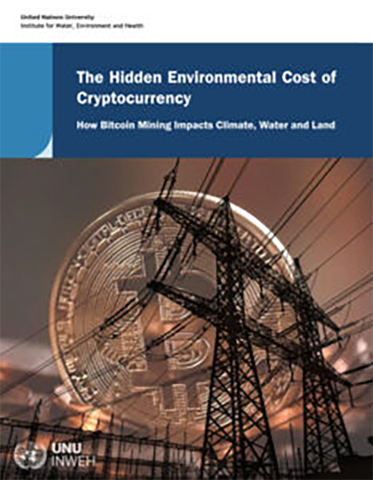Chamanara, S., Madani, K.. 2023.The Hidden Environmental Cost of Cryptocurrency: How Bitcoin Mining Impacts Climate, Water and Land. United Nations, University Institute for Water, Environment and Health (UNU-INWEH), Hamilton, Canada, doi: 10.53328/INR23ASC02.
Download the report

This report offers the first multi-attribute estimation of the environmental footprint of the global BTC mining network, including its carbon, water, and land footprints. The primary objectives of this assessment include assessing the environmental impact of BTC mining, providing a global perspective by evaluating the mining activities of different nations, and emphasizing the need for immediate policy interventions to monitor, regulate, and mitigate the environmental consequences of digital currencies. which play an undeniable and growing role in the global financial system.
The results show that the global BTC mining network’s electricity consumption is substantial. Price of BTC plays a crucial role in mining profitability, with higher prices driving increased mining activity and energy consumption at the global level. A 400% rise in the BTC price from 2020 to 2021, was followed by a 140% surge in the worldwide BTC network’s electricity use. In the 2020-2021 period, the global BTC mining network devoured 173 terawatt-hours (TWh) of electricity, marking a 60% increase from the 2018-2019 period. Projections for 2023 suggest that electricity consumption can exceed 135 TWh. To provide context, if BTC were considered a country, its electricity consumption in July 2023 would rank it 27th globally, outpacing populous nations such as Pakistan.
The BTC network relies heavily on fossil energy sources, with coal constituting 45% of the energy mix. This has led to the emission of more than 85.89 million metric tons of CO2-equivalent (Mt CO2 eq) from 2020 to 2021. This is equal to the amount of greenhouse gases produced by burning 84 billion pounds of coal, the output of 190 natural gas-fired power plants, or the waste produced by over 25 million tons of landfilled materials. The water footprint of BTC mining is also significant, amounting to about 1.65 cubic kilometers (km3) from 2020 to 2021. This is comparable to the volume of water required to fill over 660,000 Olympic-sized swimming pools, enough to satisfy more than 300 million people in rural Sub-Saharan Africa. Furthermore, the land footprint of BTC mining is extensive, affecting more than 1,870 square kilometers of land, 1.4 times the area of Los Angeles.
KEY FINDINGS
- The cryptocurrency sector provides valuable opportunities and benefits, but has major, overlooked environmental impacts.
- Bitcoin (BTC) as the most popular form of cryptocurrency has worrying environmental impacts on climate, water, and land.
- A substantial correlation exists between BTC price fluctuations and electricity consumption, with a 140% growth in electricity use as a result of a 400% BTC price increase from 2020 to 2021.
- China, USA, Kazakhstan, Russia, Malaysia, Canada, Germany, Iran, Ireland and Singapore were the world’s top BTC miners of the world in 2020-2021.
- 67% of the electricity consumed for BTC mining in 2020-2021 came from fossil energy sources.
- Coal, the main source of energy for BTC mining, provided 45% of the total electricity used by the global BTC mining network in 2020-2021.
- BTC mining emitted about 86 Mt of CO2 eq from 2020 to 2021.
- The greenhouse gas emissions of BTC mining alone could be sufficient to push global warming beyond the Paris Agreement’s goal of capping anthropogenic climate warming below 2 degrees Celsius.
- The top ten BTC mining nations are together responsible for 94% of the global carbon footprint of BTC
- To offset BTC mining’s 2020 and 2021 CO2 emissions, about 3.9 billion trees need to be planted.
- Hydropower, an energy resource with major water and environmental impacts, is the main renewable energy source of electricity for BTC, satisfying over 16% of the total electricity demand of the global BTC mining network.
- Nuclear energy provides 9% of the total electricity used for BTC mining globally.
- Only 2% and 5% of the total electricity used for mining BTC came from solar and wind energy sources, respectively.
- The global water footprint of BTC mining (2020-2021) equals 1.65 km3, exceeding the domestic water use of over 300 million people in rural Sub-Saharan Africa.
- The land footprint of the global BTC mining network (2020-2021) is more than 1,870 square kilometers, 1.4 times the area of Los Angeles.
- China, USA, Kazakhstan, Russia, Canada, Malaysia, Germany, Ireland, Iran, Thailand, Sweden, Norway, Singapore, and the UK are among the top contributors to the carbon, water, and land footprints of the global BTC mining network.
- China’s share in BTC mining dropped from 73% (2021) to 21% (2022) due to government’s interventions while the shares of the United States and Kazakhstan increased by 34% and 10%, respectively.
- Countries with low electricity prices like Kazakhstan, where electricity price is three times cheaper than that in the U.S., are BTC mining heavens providing major financial incentives for BTC mining that is heavily reliant on non-renewable energy sources.
- Urgent regulatory intervention and technological breakthroughs are needed to mitigate the environmental impacts of the digital currency sector which is rapidly growing.
Read the press release here
Suggested citation: "The Hidden Environmental Cost of Cryptocurrency: How Bitcoin Mining Impacts Climate, Water and Land," United Nations University, UNU-INWEH, 2023-10-24, https://unu.edu/inweh/article/hidden-environmental-cost-cryptocurrency-how-bitcoin-mining-impacts-climate-water-and.



